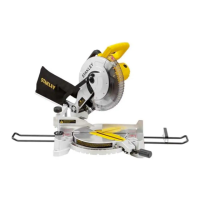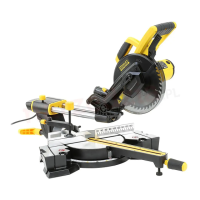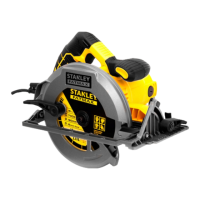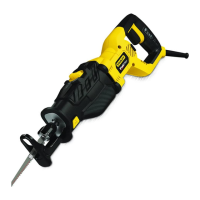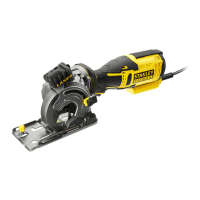29
ENGLISH (Original Instructions)
8. Base plate
9. Lower blade guard
10. Blade clamping screw
11. Lower guard lever
12. Upper blade guard
13. Lock-off button (Lock-Off button for specified regions)
WARNING: These heavy-duty circular saws are
designed for professional wood cutting
applications. Do not use water feed attachments with this
saw. Do not use abrasive wheels or blades. Do not use
under wet conditions or in the presence of flammable
liquids or gases. Do not use diamond wheels.
These heavy-duty saws are professional power tools.
Do not let children come into contact with the tool.
Supervision is required when inexperienced operators
use this tool.
♦ This product is not intended for use by persons (including
children) suffering from diminished physical, sensory or
mental abilities; lack of experience, knowledge or skills
unless they are supervised by a person responsible for
their safety. Children should never be left alone with this
product.
ASSEMBLY
WARNING! Before assembly, make sure that the tool is
switched off and unplugged.
WARNING! To reduce the risk of serious personal injury,
turn tool off and disconnect tool from power source
before making any adjustments or removing/installing
attachments or accessories. Before reconnecting the tool,
depress and release the trigger switch to ensure that the
tool is off. An accidental start-up can cause injury.
TO INSTALL THE BLADE (FIG. A–D)
1. Using the lower guard lever (11), retract the lower blade
guard (9) and place blade on saw spindle (15), making
sure that the blade will rotate in the proper direction (the
direction of the rotation arrow on the saw blade and the
teeth must point in the same direction as the direction
of rotation arrow on the saw). Do not assume that the
printing on the blade will always be facing you when
properly installed. When retracting the lower blade
guard to install the blade, check the condition and
operation of the lower blade guard to assure that it is
working properly. Make sure it moves freely and does
not touch the blade or any other part, in all angles and
depths of cut.
2. Place outer clamp washer (14) on saw spindle with the
large flat surface against the blade and the wording on
the outer clamp washer facing you.
3. Thread blade clamping screw (10) into saw spindle by
hand (screw has right-hand threads and must be turned
clockwise to tighten).
4. Depress the blade lock (3) while turning the saw spindle
with the blade wrench until the blade lock engages and
the blade stops rotating.
5. Tighten the blade clamping screw firmly with the blade
wrench (19).
Note: Never engage the blade lock while saw is running, or
engage in an effort to stop the tool. Never turn the saw on
while the blade lock is engaged. Serious damage to your
saw will result.
TO REPLACE THE BLADE (FIG. B–D)
1. To loosen the blade clamping screw (10), depress the
blade lock (3) and turn the saw spindle with the blade
wrench (19) until the blade lock engages and the blade
stops rotating. With the blade lock engaged, turn the
blade clamping screw counterclockwise with the blade
wrench (screw has right-hand threads and must be
turned counterclockwise to loosen).
2. Remove the blade clamping screw (10) and outer clamp
washer (14). Remove old blade.
3. Clean any saw dust that may have accumulated in the
guard or clamp washer area and check the condition
and operation of the lower blade guard as previously
outlined. Do not lubricate this area.
4. Always use blades that are the correct size (diameter)
with the proper size and shape center hole for mounting
on the saw spindle. Always assure that the maximum
recommended speed (rpm) on the saw blade meets or
exceeds the speed (rpm) of the saw.
5. Follow steps 1 through 5 under To Install the Blade,
making sure that the blade will rotate in the proper
direction.
LOWER BLADE GUARD
WARNING! The lower blade guard is a safety feature
which reduces the risk of serious personal injury. Never
use the saw if the lower guard is missing, damaged,
misassembled or not working properly. Do not rely
on the lower blade guard to protect you under all
circumstances. Your safety depends on following all
warnings and precautions as well as proper operation
of the saw. Check lower guard for proper closing before
each use. If the lower blade guard is missing or not
working properly, have the saw serviced before using. To
assure product safety and reliability, repair, maintenance
and adjustment should be performed by an authorized
service center or other qualified service organization,
always using identical replacement parts.
WARNING! Never use the saw whose lower guad
kept opening by adding a wedge, string, rubber
band, or other materials.
CHECKING THE LOWER GUARD (FIG.A)
1. Turn tool off and disconnect from power supply.
2. Rotate the lower guard lever (11) from the fully closed
position to the fully open position.
3. Release the lever and observe the lower guard (9)
return to the fully closed position.
The tool should be serviced by a qualified service center if it:
♦ fails to return to the fully closed position,
♦ moves intermittently or slowly, or
♦ contacts the blade or any part of the tool in all angles
and depth of cut.
